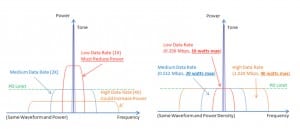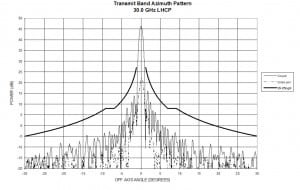Latest News
Power density is the single most important operating parameter for transmitting earth stations and probably the least understood by operators of satellite communication terminals. In this two-part article, we will define what power density is, the role it plays in the design of satellite networks and the licensing of satellite terminals, how easy it is to exceed the regulatory limit and the problems that result and, finally, what we can do to reduce these problems to an acceptable level.
Most terminal operators can tell you how much power they are transmitting and what data rates they are achieving up and down. This is good information to know, but it is not good enough to ensure that the terminal is operating at its best and within regulatory limits. The official document issued by the satellite operator or regulatory agency that authorizes a terminal to transmit specifies its maximum allowed power density. Operating a terminal without knowing the current value of this critical parameter can lead to two very negative results: (1) self-interference due to transponder overload and (2) excessive interference with other users on the same and neighboring satellites. Either of these outcomes, especially number (2), could lead to the temporary or permanent revocation of a terminal’s license to transmit.
Power density figures prominently in the license that every transmitting earth station must obtain in order to operate. Unfortunately, the license document typically offers no guidance regarding what the specified maximum power density value means in terms that operators are familiar with, such as High-Power Amplifier / Block Up-Converter (HPA/BUC) power level and signal parameters such as data rate and modulation type. Very few terminals directly monitor or control power density, but almost all allow the operator to change it. For that reason, it is relatively easy for the operator to unintentionally turn his fully compliant and approved terminal into a very effective source of interference on his, and other, satellite communication systems.
What is Power Density?
Simply put, power density describes how the transmit power in a communications signal is distributed over frequency. It is expressed in terms of power divided by a relatively small unit of bandwidth (e.g. dBW/4kHz) and is usually referenced to the input of the satellite terminal’s antenna. The unit dBW, or dB-Watts, is the universally accepted way of expressing power on a log10 scale (dBW = 10 log10 [PWatts]). Bandwidth is a factor since all satellite signals spread their power across a range of frequencies. The speed at which digital information flows is the data rate of the signal. In general, as the data rate of a signal increases, so does the range of frequencies occupied by that signal. Assuming total power in the signal is constant; increasing the data rate will spread power over a wider range of frequencies and decrease power density. The inverse is also true. Figure 1 shows the power spectrums of several data signals. All use the same waveform (modulation and coding). As you can see in the figure, a simple change to data rate can make a substantial change in power density and lead to operation well above or below the power density target / limit.
Power density figures prominently in the design of a satellite network that must make optimal use of its assigned transponder or bandwidth (portion of a transponder) on the satellite. Every terminal in the network is allocated a certain power level and carrier bandwidth (power density) such that all users combined optimally load the satellite transponder. A terminal operating at slightly below its allocated power density level suffers little ill effect and will cause no issue to others. However, operating above the limit can quickly lead to an overload condition that degrades communication channel performance for that terminal and every other terminal sharing that same transponder, including users that may not be on the offending terminal’s network.
Transponder overload was a common and very serious problem when most remote terminals operated “open-loop.” Today, the vast majority of terminals “close the loop” with the network operations center and adjust their transmit power density based on the amount of power received on the other end of the return link. This power management approach is referred to as Uplink Power Control (UPC). In this way, the network operator can ensure that his system is getting maximum usage of the satellite resources assigned to his network without overloading the transponder. However, all risks associated with excessive power density are not removed by UPC.
Power density is also an important parameter when assessing the potential for interference between satellite communication signals, but this has not always been the case. In the early days of Ku-band satellite licensing and the build out of services, most of our industry’s attention was focused on the terminal antenna’s sidelobe performance and maximum allowed EIRP (Effective Isotropic Radiated Power), especially the former. That focus gave rise to the now famous, at least among antenna designers, 29 – 25 log – dBi curve. When plotted along with the pattern of a parabolic reflector antenna optimized for use in a satellite system, this curve follows the peaks of the antenna’s sidelobes very well out to a relatively large angle (> 30 degrees). See Figure 2 for an example. A terminal’s EIRP is a measure of its raw power and is calculated by adding the maximum power produced by the HPA/BUC (in dBW) to the peak gain of the antenna (in dBi).
A typical maximum EIRP value for a 1.2M Ku-band antenna with a 20 W BUC is 54.5 dBW. This raw power number was a useful measure for assessing potential interference when satellite links were not as diverse as they are today. In those early days, technology limited the link designer’s choices and the assumptions he had to make about the amount of interfering power seen from sources outside his network were fairly reliable and reasonable. As technology advanced over the years and more advanced waveforms (signal modulation and coding) were developed, the character of satellite links changed. Knowing what the maximum EIRP of an interfering signal might be was no longer enough information to make reasonable design decisions or QoS commitments.
In part two, we will describe how power density is used to enable the use of small / disadvantaged terminals, how easy it is to configure a typical terminal to exceed the limit and cause trouble and what we should consider doing to improve the situation.
Get the latest Via Satellite news!
Subscribe Now
